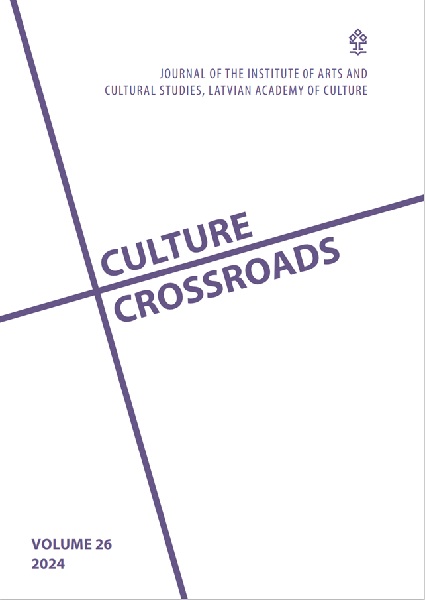CULTURAL PARTICIPATION AND YOUTH WELLBEING: AN EXAMPLE OF THE MEMORIAL MUSEUM OF EDUARDS VEIDENBAUMS “KALĀČI”
DOI:
https://doi.org/10.55877/cc.vol26.496Keywords:
cultural participation, museum, youth, wellbeing, participatory researchAbstract
In recent years, the field of social science research has increasingly sought to explain the role of cultural participation in promoting social and individual wellbeing. It has been studied in different cultural and artistic subsectors, including museums [Daykin et al. 2020]. The focus of this paper is on young people’s participation in cultural activities, specifically museum activities, and the impact of this participation on young people’s wellbeing. Fieldwork was carried out in the Memorial Museum of Eduards Veidenbaums “Kalāči” during the research project “Striving Towards Participatory Engagement in Museums: Inquiry into Museum Education Practice in Latvia (MEET), meeting young people (n=12) and finding out what their experience was of participating in the creation of the museum’s permanent exhibition and by organising events like “Veindenfest” (“Veidenfests”) and “More Light” (“Vairāk gaismas”). Paper reveals how participation in these activities has contributed to young people’s wellbeing.
Downloads
References
Aked, J., Marks, N., Cordon, C., and Thompson, S. (2008). A report presented to the Foresight Project on communicating the evidence base for improving people’s well-being. Available: https://neweconomics.org/uploads/files/five-ways-to-wellbeing-1.pdf (viewed 06.02.2024.)
Bungay, H., and Vella-Burrows, T. (2013). The effects of participating in creative activities on the health and well-being of children and young people: a rapid review of the literature. Perspectives in Public Health, 133(1), pp. 44–52. Available: doi:https://doi.org/10.1177/1757913912466946
Cameron, M., Crane, N., Ings, R., and Taylor, K. (2013). Promoting well-being through creativity: how arts and public health can learn from each other. Perspectives in Public Health, 133(1), pp. 52–59. Available: doi:https://doi.org/10.1177/1757913912466951
Cargo, M., Mercer, S. L. (2008). The Value and Challenges of Participatory Research: Strengthening Its Practice. Annual Review of Public Health, Vol. 29, Issue 1, pp. 325–350. Available: 10.1146/annurev.publhealth.29.091307.083824
Davies, C. R., Rosenberg, M., Knuiman, M., Ferguson, R., Pikora, T., and Slatter, N. (2012). Defining arts engagement for population-based health research: Art forms, activities and level of engagement. Arts & Health, 4(3), pp. 203–216. Available: doi:https://doi.org/10.1080/17533015.2012.656201
Daykin, N., Mansfield, L., Meads, C., Gray, K., Golding, A., Tomlinson, A., and Victor, C. (2020). The role of social capital in participatory arts for wellbeing: findings from a qualitative systematic review. Arts & Health, pp. 1–24. Available: doi:https://doi.org/10.1080/17533015.2020.1802605
Fancourt, D., and Finn, S. (2019). What is the evidence on the role of the arts in improving health and well-being? A scoping review. Copenhagen: WHO Regional Office for Europe. Available: https://www.ncbi.nlm.nih.gov/books/NBK553773/ (viewed 04.02.2024.)
Fenton, H. (2013). Museums, participatory arts activities and wellbeing. Teaching in lifelong learning., 5(1), pp. 5–12. Available: doi:https://doi.org/10.5920/till.2013.515
The Government Office for Science, London. Foresight Mental Capital and Wellbeing Project (2008). Mental Capital and Wellbeing: Making the most of ourselves in the 21st century. Available: https://assets.publishing.service.gov.uk/media/5a7ce5afed915d36e95f0526/mental-capital-wellbeing-summary.pdf (viewed 04.02.2024.)
Hand, C. (2017). Do the arts make you happy? A quantile regression approach. Journal of Cultural Economics, 42(2), pp. 271–286. Available: doi:https://doi.org/10.1007/s10824-017-9302-4
Hui, A., Stickley, T., Stubley, M., and Baker, F. (2019). Project eARTh: participatory arts and mental health recovery, a qualitative study. Perspectives in Public Health, 139(6), pp. 296–302. Available: doi:https://doi.org/10.1177/1757913918817575
Hurtubise, K., Joslin, R. (2023). Participant-Generated Timelines: A Participatory Tool to Explore Young People With Chronic Pain and Parents’ Narratives of Their Healthcare Experiences. Qualitative Health Research. Vol. 33, Issue 11. Available: https://doi.org/10.1177/10497323231189388
International Council of Museums (2022). Museum Definition. ICOM. Available: https://icom.museum/en/resources/standards-guidelines/museum-definition/ (viewed 07.02.2024.)
Jenkins, L. K., Farrer, R., and Aujla, I. J. (2020). Understanding the impact of an intergenerational arts and health project: a study into the psychological well-being of participants, carers and artists. Public Health, 194, pp. 121–126. Available: doi:https://doi.org/10.1016/j.puhe.2021.02.029
Jensen, A. (2013). Beyond the borders: The use of art participation for the promotion of health and well-being in Britain and Denmark. Arts & Health, 5(3), pp. 204–215. Available: doi:https://doi.org/10.1080/17533015.2013.817448
Kovich, M. K., Simpson, V. L., Foli, K. J., Hass, Z., & Phillips, R. G. (2023). Application of the PERMA model of well-being in undergraduate students. International journal of community well-being, 6(1), 1–20. Available: https://link.springer.com/article/10.1007/s42413-022-00184-4
Mansfield, L., Daykin, N., Tomlinson, A., Meads, C., Gray, K., Golding, A., and Victor, C. (2019). A Qualitative Evidence Review of Space and Place, Intangible Assets and Volunteering and Participatory Arts and Sport or Physical Activity for Enhancing Wellbeing or Alleviating Loneliness across the Adult Life course (16+ years) A Synthesis of Qualitative Studies: Intangible Assets. Available: https://whatworkswellbeing.org/wp-content/uploads/2020/07/proofedQUALSYN_IA_3.20.pdf (viewed 05.02.2024.)
O’Donnell, S., Lohan, M., Oliffe, J. L., Grant, D., and Galway, K. (2021). The acceptability, effectiveness and gender responsiveness of participatory arts interventions in promoting mental health and Wellbeing: a systematic review. Arts & Health, pp. 1–18. Available: doi:https://doi.org/10.1080/17533015.2021.1894463
Pesata, V., Colverson, A., Sonke, J., Morgan-Daniel, J., Schaefer, N., Sams, K., Carrion, F. M.-E., and Hanson, S. (2022). Engaging the Arts for Wellbeing in the United States of America: A Scoping Review. Frontiers in Psychology, 12. Available: doi:https://doi.org/10.3389/fpsyg.2021.791773
Seligman, M. E. P. (2011). Flourish: A Visionary New Understanding of Happiness and Well-being. New York: Free Press.
Sollis, K. (2023). Participatory Wellbeing Frameworks and the Secret to Impact. Journal of Human Development and Capabilities. Vol. 24, Issue 2, pp. 163–193. Available: https://doi.org/10.1080/19452829.2023.2200238
Williams, E., Glew, S., Newman, H., Kapka, A., Shaughnessy, N., Herbert, R., Walduck, J., Foster, A., Cooke, P., Pethybridge, R., Shaughnessy, C., and Hugh-Jones, S. (2023). Practitioner Review: Effectiveness and mechanisms of change in participatory arts-based programmes for promoting youth mental health and well-being – a systematic review. Journal of Child Psychology and Psychiatry. Available: doi:https://doi.org/10.1111/jcpp.13900
Zarobe, L., and Bungay, H. (2017). The role of arts activities in developing resilience and mental wellbeing in children and young people a rapid review of the literature. Perspectives in Public Health, 137(6), pp. 337–347. Available:doi:https://doi.org/10.1177/1757913917712283
Downloads
Published
Issue
Section
License
Copyright (c) 2025 Culture Crossroads

This work is licensed under a Creative Commons Attribution 4.0 International License.


